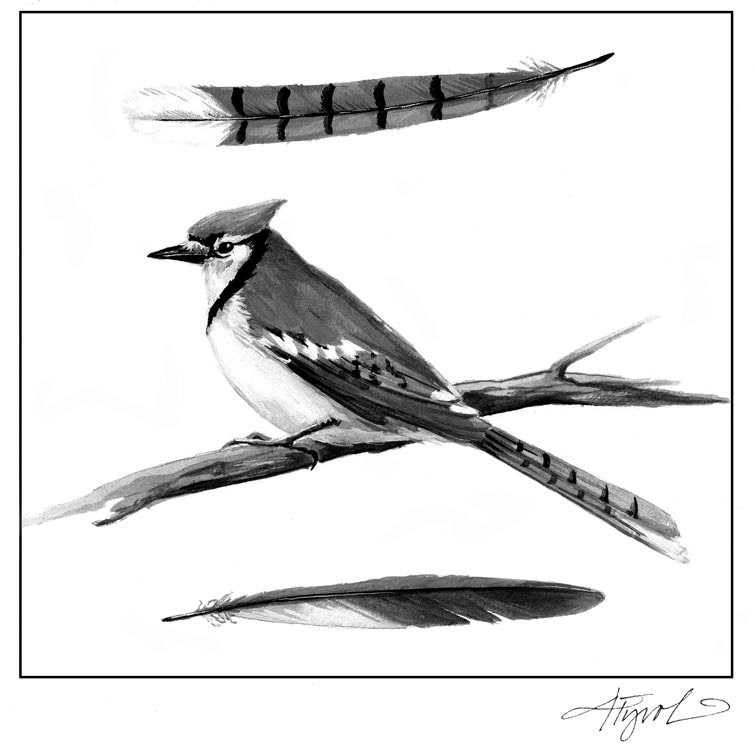
Animals display a dazzling variety of colors, particularly in the tropics. But even here in northern New England where wildlife diversity is comparatively limited, we enjoy a rich palette of colors and patterns. The majority of colors are produced by pigments–particles of color chemicals found within specialized cells. These include melanins, which are found in nearly all organisms and produce the earthy tones common to many animals (including humans), and carotenoids, which produce colors primarily in the red to yellow end of the spectrum (think northern cardinal and American goldfinch). What’s surprising, however, is that pigments that produce blue coloration are all but unknown in the animal kingdom, even though we have plenty of blue-colored animals, particularly among birds, butterflies, and fish. So if it’s not pigments, what makes an animal blue?
When we see a blue jay or an indigo bunting, the intense blue that we perceive is due to the microscopic structure of its feathers and the way they reflect blue and violet light. This is known as structural coloration. In fact, among vertebrates, there are only two known examples of blue color deriving from a blue pigment. Furthermore, for amphibians, reptiles, and some birds, the scattering of blue wavelengths, together with the presence of yellow pigmentation, is fundamental for the expression of the color green.
A simple way to experience structural coloration is to hold a blue feather up to the sky so it is backlit. With sunlight streaming through the feather, rather than bouncing off its surface, the blue color vanishes, and the feather appears a drab greyish-brown. But, bring the feather down so the light bounces off, scattering blue wavelengths of light, and the feather appears blue once again. Structural coloration is also responsible for a variety of color phenomena, including iridescence and sky color. Indeed, for many years scientists thought birds look blue for the same reason the sky does: red and yellow wavelengths pass through the atmosphere, but shorter blue wavelengths bounce off gas molecules and scatter, emitting a blue glow in every direction. But Richard Prum, an ornithologist at Yale University, discovered that the blue in birds’ feathers is slightly different.
Prum discovered that as a blue feather grows, protein molecules called keratin (located within the feather cells) separate from water, like oil from vinegar. When the cells die, the water evaporates and is replaced by air, leaving a specific structure of keratin interspersed with air pockets. This three-dimensional arrangement of the keratin/air layers within feather barbs is what reflects blue wavelengths of light back to our eyes. Prum also discovered that different shapes and sizes of these keratin/air layers create the different shades of blue that we see among various species of birds. However, even though blue is a structural color, what’s key to this entire phenomenon is the presence of the pigment melanin, because without it, all blue birds would look white.
Underlying the keratin structure of a feather is a layer of melanin, which absorbs red and yellow wavelengths. Without melanin (or other pigment cells), all the wavelengths would be reflected back to our eyes, resulting in pure white feathers. When this occurs in feathers or hair that normally have color, it is known as leucism– sometimes mistakenly referred to as partial albinism. (Albinism occurs when melanin is absent from all cells, including skin and eyes.)
Blue skin in amphibians is relatively uncommon. Notable exceptions include the blue-spotted salamander and the South American blue poison dart frog. However, since green pigmentation is not normally present in amphibians, the structural expression of blue wavelengths from amphibian skin is essential for the green coloration of many frogs. Basically, the shorter blue wavelengths of light are largely absorbed by the filtering yellow pigment layer, reflecting the yellow-green wavelengths back to our eye. Occasionally, however, due to a genetic mutation, frogs that normally appear green – such as the American bullfrog and green frog – lack the yellow pigments in their skin, making them appear blue.
The same phenomenon that makes amphibians green also occurs with many reptiles. In our area, the yellow pigments of the smooth green snake combine with the physical structure of its scales to make it appear as green as your lawn in mid-June. But shortly after the snake dies, the yellow pigments break down chemically, and the snake takes on an iridescent blue appearance.
To date, only two vertebrates have been found that have blue coloring as a result of cellular pigment called cyanophores. Both the Mandarin fish and the closely-related psychedelic Mandarin (also called the picturesque dragonet) are vividly-colored fish native to coral reefs in the Pacific Ocean. You might say that these small, stunning fish, which are popular in the saltwater aquarium trade, are the only animals worthy of being called true blue.


Discussion *